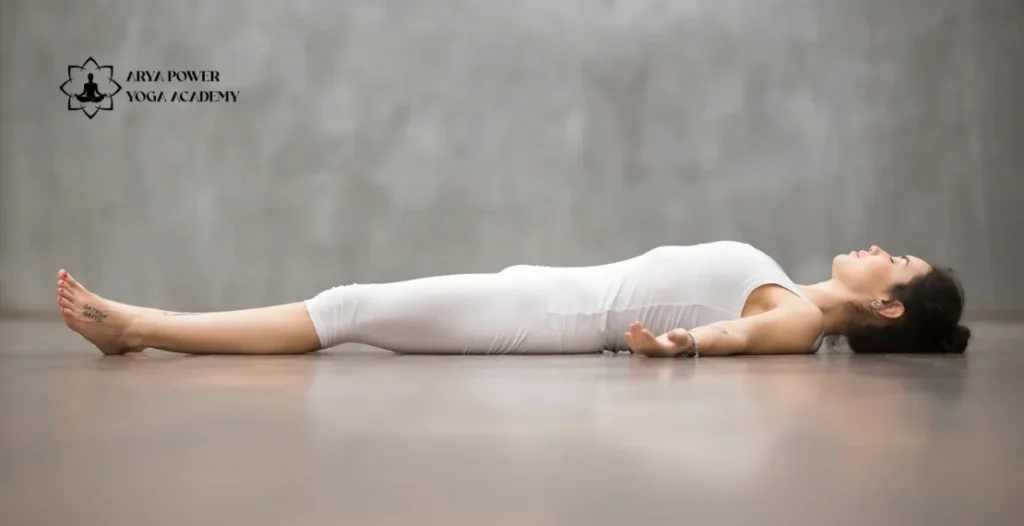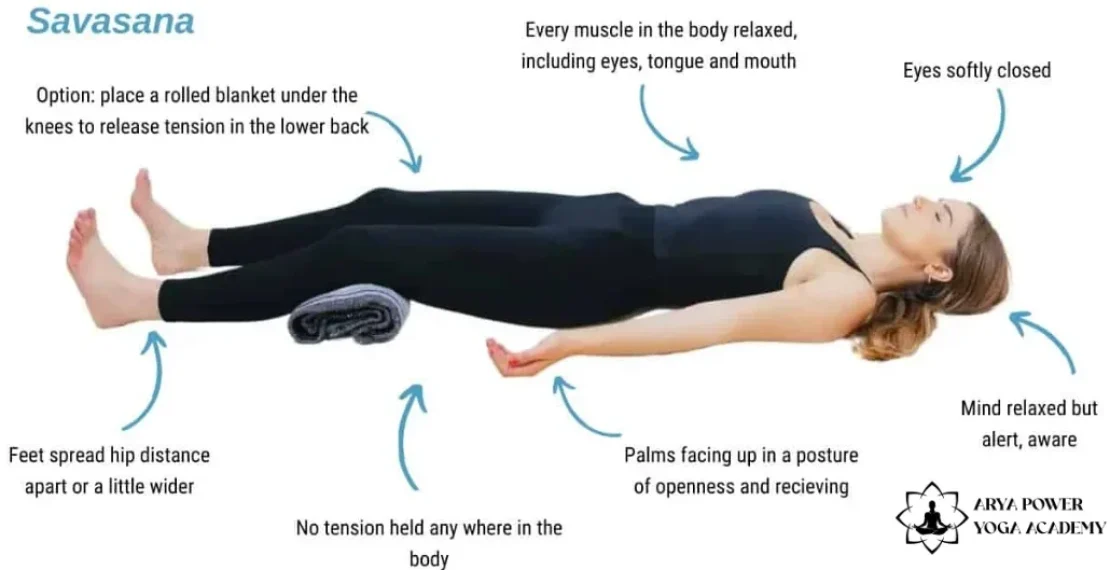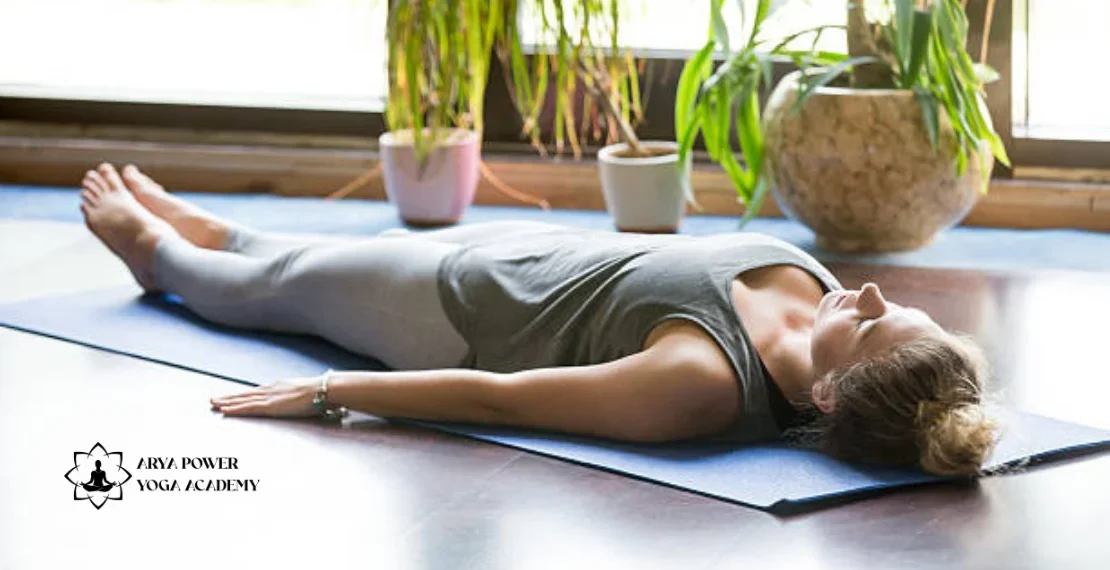admin
August 25, 2025
Savasana Yoga (Corpse Pose): Steps, Benefits & Why It’s the Most Powerful Yoga Pose

Did you even know that the most relaxing pose is actually the most transformative one?
You read it right— Savasana Yoga, or the Corpse Pose Yoga as you’d call it, looks deceivingly simple but it has an almost magical ability to relax, revitalize, and heal the body, as well as the mind.
At first glance, it might seem as though you’re just lying on your back, not doing anything. Savasana (pronounced shah-VAH-suh-nuh) is one of the most vital and powerful aspects of yoga practice. It is traditionally practiced at the end of a session, allowing your body to receive, assimilate, and integrate all of the work you have just experienced: from movement and breath to energy shifts and emotional release.
And although it’s simple, it’s something that many of us tend to either blow off or skip…but not realizing its true potential. The irony is that Savasana seems passive, but it actually requires deep internal focus and attention. It’s a deliberate action of stillness, surrender, and total release.
In today’s fast-paced, over-sensory world, taking the Savasana pose becomes not just a rare act of self-care but a powerful practice of transmutation. It soothes the nervous system, declutters the mind, and reconnects you with your inner stillness.
In this blog, we’re going to explore what real Savasana Yoga is, its dynamic benefits, how to do it correctly, and why it’s so much more than a pose—it’s a pathway to wholeness.
What is Savasana (Corpse Pose)?
Savasana comes from the ancient language of Sanskrit, where “Shava” represents corpse and “Asana” means position. Together, Savasana means Corpse Pose—a pose to mirror the stillness and surrender of a dead body. But the name is not to be taken at face value. Although the pose might look still from the outside, it is a very conscious and powerful practice within.
Savasana Yoga is the traditional form of yoga that is done at the end of yoga practice. Once the body has been moved and stretched and strengthened, and twisted, Savasana can bring on one last release — a sacred pause that gives your body and mind time to absorb the benefits of all of the work you’ve just done. It is a time for reflection, recalibration, and restoration.
Myth vs. Truth: “It’s Just Lying Down”
Many people, especially beginners, believe Savasana is the easiest yoga pose—after all, you’re simply lying flat on your back, right? The reality, however, is quite the opposite. True Savasana calls for total presence, full awareness, and profound relaxation, altogether, and without effort. There’s no movement to hide behind, no breath work to concentrate on — just you, your body, and your mind in stillness.
In that silence, the nervous system gets permission to fully reset. This is where healing begins, and why Savasana Yoga is considered one of the most profound tools for physical, mental, and emotional balance. Far from being “just lying down,” it is the culmination of yoga itself.
How to Do Savasana (Step-by-Step Guide)

Doing the Savasana pose properly is much more than just lying on the ground. The pose looks stagnant and passive; however, it takes thoughtful attention, physical extension and mental grounding to fully realize the pose’s restorative benefits. Whether you’re wrapping up a tough yoga flow or just looking for a little relaxation, learning how to do Savasana correctly can turn this relaxing pose into active restoration.
Step-by-Step: Savasana Steps for Maximum Benefit
Lie flat on your back on a yoga mat or any comfortable surface. Your back should feel supported and aligned.
Allow your arms to rest at your sides, slightly away from the torso, palms up—a symbolic action of openness and surrender.
Situate your legs around hip-width or wider, allowing your feet to flop outward naturally. Don’t tense or try.
Gently close your eyes, release the eyelids, and begin to soften the jaw, forehead, shoulders, and the space between the eyebrows.
Breathe in slowly and deeply, and exhale again to signal your body that it’s time to release. Then, simply allow your breath to return to its regular rhythm, without attempting to control it.
Now, starting at the crown of your head and making your way down, bring gentle awareness to your body. Observe and release any residual tension you may find.
Focus on slow breathing and maintain body awareness without judgment. If your mind drifts, kindly bring your attention back to the breath or body sensations.
Pro Tip: Comfort is key for reaping the Savasana benefits. Use props such as a folded blanket under your knees if you feel any strain in the lower back, or a small pillow under your head if you need neck support. You can also roll up a towel under your wrists or ankles for support. This makes it easier to stay in Savasana pose longer and truly relax.
Benefits of Savasana: Why You Should Never Skip It
There is more to the positive effects of Savasana than relaxation. This simple pose does wonders for the body, mind, and soul. Savasana Yoga is described as the centering finish to a yoga practice where movement connects to mind and body in harmony. Now, whether you are mentally exhausted, physically tired, or spiritually disconnected, taking the Savasana pose in yoga can be one of the most healing practices when used wisely. Let’s break down the most significant Savasana benefits.
Physical Benefits of Savasana
Muscular Relaxation: The position encourages the body to let go of stored tension, aiding muscle recovery and lessening stiffness.
Combat Tiredness: Savasana Yoga fights tiredness by inducing complete rest – it rejuvenates the body after work.
Reduces Blood Pressure & Heart Rate: Deep relaxation also activates the parasympathetic nervous system, leading to a calmer cardiovascular state.
Deep Healing: As you reset, it allows your body to find its balance, promoting its natural healing processes.
Practicing these Savasana steps post-yoga allows your body to soak up the rainbow of benefits you just worked off your yoga mat, giving the whole system a full somatic reset.
Mental Benefits of Savasana
Nervous System Reset: Savasana relaxes the central nervous system, serving as an antidote to chronic stress, and feels like a refresh for the brain.
Emotional clarity: It opens up a space for emotions to settle and evaporates the anxiety and depression.
Enhanced Focus: The Savasana pose boosts mental clarity by eliminating brain fog.
Mind-Body Unison: Your last few minutes on a yoga mat are when the body and mind begin to harmonize.
These are just a few of the mental Savasana benefits that prove it’s not only a pose for relaxation, but also a transformational journey towards emotional resilience.
Spiritual Benefits of Savasana
Encourages Mindfulness: Lying still allows you to simply be, to observe thoughts without attachment or resistance.
Inner Peace: Consistent practice brings a stronger connection with your inner self, cultivating tranquility and acceptance.
Spiritual surrender: As you release control, you make room for spiritual awakening or inner breakthrough.
By following the right Savasana steps, you create a space for sacred stillness that nourishes your system, body, mind, and spirit.
Is Savasana Good for Sleep?
Absolutely. And if you’re wondering if Savasana is good for sleep, the answer is a solid yes. Savasana pose before bed can help your body relax, slow your breath and prepare your nervous system for deep rest. It’s especially beneficial for people with insomnia or who experience nighttime anxiety. Want better sleep? Find an Intention Stacking is essential in creating savasana flow, but a few minutes of intention-setting is a powerful practice in itself. The effects of Savasana are not only experienced during your yoga practice — they ripple into every area of your life, including your quality of sleep.
Common Mistakes to Avoid in Savasana
Savasana Yoga might seem simple, however, it is surprisingly easy to disrupt the restorative effects of the pose with some common mistakes. To truly reap the Savasana benefits, attention to subtle details is crucial. Even minor tension or mental distraction can prevent you from fully dropping into rest.
Here are the most common mistakes when doing the Savasana pose to be avoided:
Tension in the shoulders, jaw, or hands: These spots tend to hold unconscious tension. A body scan walked up during Savasana can help you recognize and let go of tightness, so you can fully relax.
Trying too hard to “relax”: Ironically, forcing relaxation defeats the purpose of Corpse Pose Yoga. Let go of effort and let relaxation emerge naturally.
Letting the mind wander: Some thought drift is normal, but awareness is key. Gently redirect your attention to your breath or the feelings in your body when your mind wanders.
Falling asleep: If doing anything other than Yoga Nidra or sleeping, you should strive to remain fully awake. Savasana is about conscious rest, not unconsciousness.
Avoiding these mistakes makes a major difference in how effective and restorative your experience of Savasana pose will be.
When and How Often Should You Practice Savasana?

Savasana Yoga is not limited to the last few minutes of a yoga class—it can serve as a practice all on its own for the most profound relaxation and nervous system regulation. Learning to do Savasana properly makes even short sessions powerfully effective tools for balance and well-being.
Ideal Times to Practice:
After yoga practice: This is the most conventional time for Corpse Pose Yoga. It permits the body to assimilate the material and subtle changes from your asana, pranayama, or meditation.
Pre-sleep: Savasana before going to bed helps to relax the mind and prepare the body for sleep.
In times of high stress: When you’re feeling stressed, a few minutes of Savasana Yoga can help focus your mind and reduce cortisol levels.
Post-workout recovery: It’ll calm the muscles, steady the breath, and help ease you down gently.
Frequency & Duration:
We recommend a daily Savasana practice, even if it’s just a few minutes each day, to receive deep rest and deepen the impact of the benefits that come from Savasana into your life.
If you have chronic stress, insomnia, or fatigue, increase your time to 20–30 minutes.
Adding gentle soundscapes like soft music or a guided meditation can amplify the calming effects of Corpse Pose Yoga.
Learning how to do Savasana daily will gradually shift your stress patterns and bring you closer to a state of lasting inner calm.
Savasana Variations and Modifications
Not everybody finds comfort in the traditional Savasana pose. Luckily, there are plenty of variations and props that make this powerful pose more accessible and enjoyable for everyone.
- Props-Based Savasana
Blanket under the knees: Eases pressure on the lower back.
Bolster under the thighs: Opens up the hips and enhances relaxation.
Eye pillow or mask: Blocks light and encourages a deeper inward experience during your Savasana steps.
- Chair Savasana
An excellent option for senior citizens, other individuals with mobility issues, or those recovering from an injury. Sit in a sturdy chair, with the feet on the floor, and place the hands on the lap or thighs. Concentrate on your breathing and allow your entire body to relax into whatever is supporting it. This Seated Savasana Yoga offers most of the same benefits of savasana but without having to lie down.
- Side-Lying Savasana
Ideal for pregnancy, back issues or general discomfort sleeping flat. Lay on your side with a pillow in between your knees and another one under your head. This Corpse Pose Yoga Pose is easy on the spine and relaxing without being lazy. If you’re practicing in a studio or bedroom or a chair, modifying your Savasana pose will allow its therapeutic benefits to be at your fingertips.
Savasana vs Yoga Nidra: What’s the Difference?
Though both are deeply restful, Savasana Yoga and Yoga Nidra serve distinct purposes.
Feature Savasana Yoga Nidra
Position Reclining (Corpse Pose Yoga) Same reclining position
Practice Passive relaxation Guided meditation
Purpose Release physical & mental tension Explore consciousness, deep rest
Awareness Level Light meditative state Deep meditative (hypnagogic) state
Yoga Nidra can be practiced within Savasana Pose, but it takes you on a guided journey through different layers of consciousness, using breath and visualization to access deep inner states.
Savasana in Modern Yoga and Daily Life
In a world that doesn’t know how to slow down, we are constantly overstimulated—phones buzzing, to-do lists growing, stress building. Savasana offers a vital pause in that cycle.
You don’t need to be in a yoga class to benefit. You can practice Savasana Yoga:
- After a workout to bring your system back to neutral.
- On your lunch break to restore mental focus.
- During emotional overwhelm to ground and calm.
- At the end of your day to transition into sleep mode.
Even 10 minutes of Savasana daily can rewire your stress response, improve sleep, and make you feel more present in your life.
Conclusion
Savasana Yoga or Corpse Pose Yoga, is the highest form of conscious relaxation and surrender. While you might look like you’re just lying on the floor, the Savasana posture is incredibly advanced and one of the most transformational aspects of your yoga practice. It provides the sacred space where the body integrates effort, the mind finds stillness, and the spirit reconnects with its essence.
Often skipped or rushed, Savasana Yoga possesses some of the most potent and enduring results of all of your practice. Whether your intentions are to find rest, let go of stress, heal emotional wounding, or gain spiritual insight, there’s no denying the effectiveness of Savasana.
So the next time you’re tempted to roll up your mat prematurely, think twice: Skipping the Corpse Pose Yoga might lead to skipping the most important part of your practice. No matter if you’re a regular pro or just a beginner, accepting the gift of Shavasana every day will deliver you more calm, perspective, change, and awareness.
Final Thought:
Savasana Yoga isn’t the end. It’s the beginning of deep, meaningful change.
FAQs
Yes! One of the easiest and best ways to signal your nervous system to relax is to practice Savasana Yoga daily. Even just five minutes of Savasana can help contribute to your general health and happiness. Incorporating Corpse Pose Yoga into your regular practice allows the longer Savasana benefits to accumulate.
The best times to practice Savasana Yoga are after doing Yoga or Pilates, before you go to bed, or whenever you need to calm the mind. Dry Fasting Corpse Pose Yoga at night is the most helpful for sleep and recovery.
Ideally, you remain lightly aware during the Savasana pose; you can sleep sometimes, especially use it as a bedtime routine, or if you’re doing Yoga Nidra.
Absolutely. One of the most profound benefits of Savasana is how effectively it calms anxiety and balances the nervous system. The Savasana benefits extend to emotional and mental clarity.
A minimum of 5–10 minutes is great, but extending Corpse Pose Yoga to 20–30 minutes, with props, enhances all the benefits of Savasana significantly.


[…] Benefits, How-Tos & A Class That Transforms Your Skin NaturallySeptember 17, 2025 Savasana Yoga (Corpse Pose): Steps, Benefits & Why It’s the Most Powerful Yoga PoseAugust 25,… Bhujangasana Yoga (Cobra Pose): Steps, Benefits & Beginner Tips to Improve Posture and Spine […]
[…] Gomukhasana (Cow Face Pose): Steps, Benefits & How It Enhances Your Flexibility and Energy FlowSeptember 17, 2025 Face Yoga Exercises: Benefits, How-Tos & A Class That Transforms Your Skin NaturallySeptember 17, 2025 Savasana Yoga (Corpse Pose): Steps, Benefits & Why It’s the Most Powerful Yoga PoseAugust 25,… […]